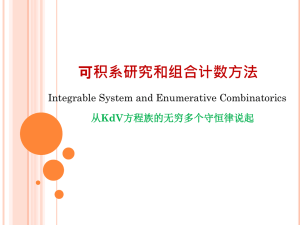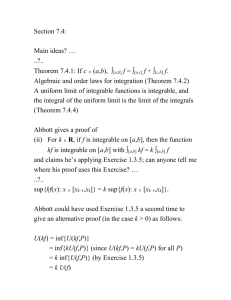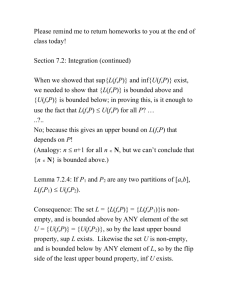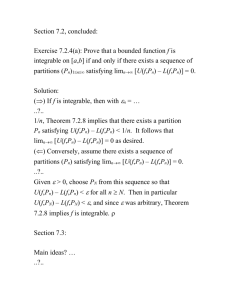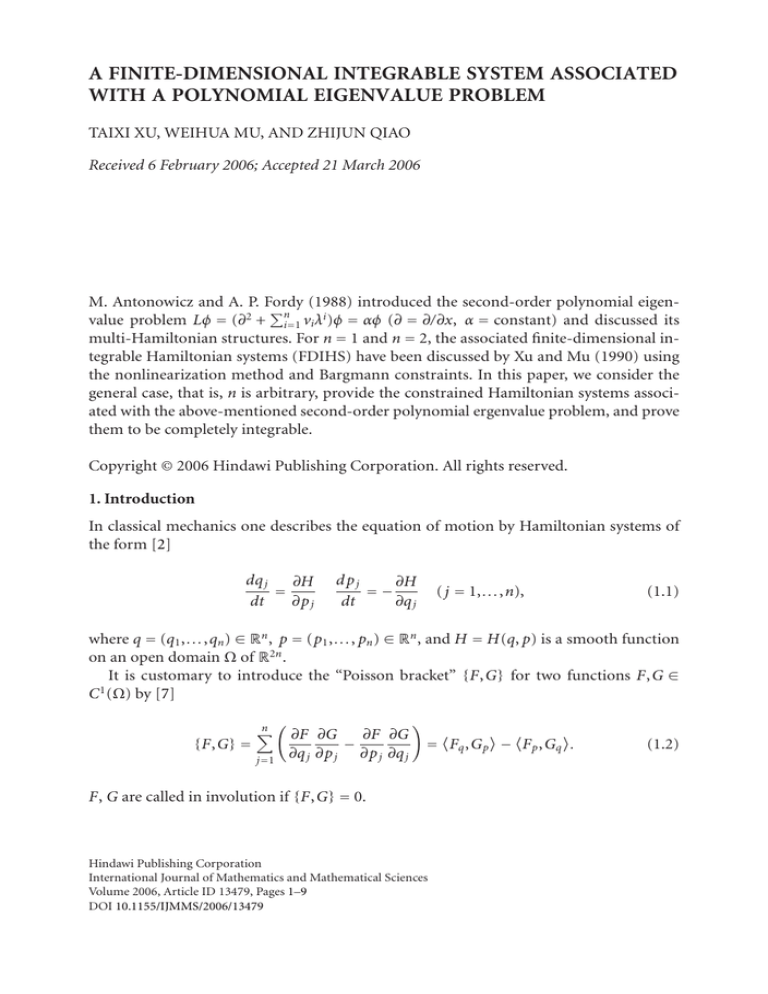
A FINITE-DIMENSIONAL INTEGRABLE SYSTEM ASSOCIATED
WITH A POLYNOMIAL EIGENVALUE PROBLEM
TAIXI XU, WEIHUA MU, AND ZHIJUN QIAO
Received 6 February 2006; Accepted 21 March 2006
M. Antonowicz and A. P. Fordy
(1988) introduced the second-order polynomial eigen
value problem Lφ = (∂2 + ni=1 vi λi )φ = αφ (∂ = ∂/∂x, α = constant) and discussed its
multi-Hamiltonian structures. For n = 1 and n = 2, the associated finite-dimensional integrable Hamiltonian systems (FDIHS) have been discussed by Xu and Mu (1990) using
the nonlinearization method and Bargmann constraints. In this paper, we consider the
general case, that is, n is arbitrary, provide the constrained Hamiltonian systems associated with the above-mentioned second-order polynomial ergenvalue problem, and prove
them to be completely integrable.
Copyright © 2006 Hindawi Publishing Corporation. All rights reserved.
1. Introduction
In classical mechanics one describes the equation of motion by Hamiltonian systems of
the form [2]
dq j ∂H
=
dt
∂p j
dpj
∂H
=−
dt
∂q j
( j = 1,...,n),
(1.1)
where q = (q1 ,..., qn ) ∈ Rn , p = (p1 ,..., pn ) ∈ Rn , and H = H(q, p) is a smooth function
on an open domain Ω of R2n .
It is customary to introduce the “Poisson bracket” {F,G} for two functions F,G ∈
C 1 (Ω) by [7]
{F,G} =
n
j =1
∂F ∂G
∂F ∂G
−
∂q j ∂p j ∂p j ∂q j
= Fq ,G p − F p ,Gq .
F, G are called in involution if {F,G} = 0.
Hindawi Publishing Corporation
International Journal of Mathematics and Mathematical Sciences
Volume 2006, Article ID 13479, Pages 1–9
DOI 10.1155/IJMMS/2006/13479
(1.2)
2
A finite-dimensional integrable system
Using a notation borrowed from differential geometry we associate with (1.1) the “vector field” or first-order differential operator
XH =
n
j =1
∂
∂
Hpj
− Hq j
.
∂q j
∂p j
(1.3)
Definition 1.1. A nonconstant function F ∈ C (Ω) is called an integral of XH if
XH F = {F,H } = 0.
(1.4)
Definition 1.2. A Hamiltonian vector field XH in Ω ⊂ R2n is called “integrable” if it possesses n integrals F j ∈ C 1 (Ω) satisfying the following conditions
(i) {F j ,H } = 0,
(ii) {F j ,Fk } = 0,
(iii) the gradients dF j are linearly independent in Ω.
The first condition expresses that the F j are integrals; the second one means that any
two such integrals commute. The third condition is a requirement for nondegeneracy,
which we will have to relax frequently.
Since Cao introduced the nonlinearization method to search for finite-dimensional
completely integrable Hamiltonian systems [3–6] associated with soliton equations, numerous such systems have been obtained by many mathematicians [8–12, 14, 15].
In this paper, we consider the integrable systems associated with the polynomial eigenvalue problem
Lφ = (∂2 +
n
vi λi )φ = αφ(∂ = ∂/∂x, α = constant).
(1.5)
i=1
When n = 1, denote v1 by v, (1.5) becomes
φxx + λvφ = αφ.
(1.6)
Equation (1.6) is associated with the Harry-Dym (HD) equation
1
2α
vt = √
+ √
2 v xxx
v
.
(1.7)
x
Remark 1.3. Actually, spectral problem (1.6) generates the Camassa-Holm (CH) equation
in its negative-order hierarchy, whereas it produces the HD equation (1.7) in its positiveorder hierarchy [9]. Both hierarchies are integrable. When n = 2, v1 = u, v2 = v, (1.5)
becomes
φxx + λu + λ2 v φ = αφ.
(1.8)
Taixi Xu et al. 3
Equation (1.8) is associated with the following coupled Harry-Dym (CHD) equation:
1
1
− 2α √
ut = √
2 v xxx
v
,
x
(1.9)
1
1
vt = 2u √ + ux √ .
v
v
We have already obtained the integrable Hamiltonian systems associated with HarryDym and coupled Harry-Dym equations [13]. For general positive integer n, the associated integrable system is given in this paper. In the next section, we give the Hamiltonian
system associated with the polynomial eigenvalue problem, and in Section 3, we obtain
the involutive integrals and prove they are linearly independent.
2. The Hamiltonian system
Consider the evolution equation
1
φtm = − Bx(m) φ + B(m) φx ,
2
(2.1)
where
B (m) =
m
−1
b j λm− j ,
b− j = 0 ( j = 1,2,...).
(2.2)
j =0
From the solvability condition of (1.5) and (2.1), the hierarchy of evolution equations of
potentials v = (v1 ,...,vn )T can be written as
⎡
0
⎢.
⎢.
⎢.
···
0
J0
·
·
⎢0
⎣
·
J0
J1
·
···
J1
..
.
vi = ⎢
⎢
Jn−1
⎤⎡
⎤
⎥ ⎢ bm−n ⎥
⎥ ⎢b
⎥ ⎢ m−n−1 ⎥
⎥⎢ . ⎥
.
⎥⎢ . ⎥
⎥⎣ . ⎥
⎦
⎦
(2.3)
bm−1
Also, from the solvability condition, it is found that bk satisfies
J0 b j + J1 b j+1 + · · · + Jn b j+n = 0,
(2.4)
or
K b j ,b j+1 ,...,b j+n−1
T
T
= J b j+1 ,b j+2 ,...,b j+n ,
(2.5)
or
KG j = JG j+1 ,
(2.6)
4
A finite-dimensional integrable system
where
⎡
0
⎢.
⎢.
⎢.
···
·
·
⎢0
⎣
·
J0
J1
·
···
K =⎢
⎢
J0
0
J1
..
.
⎡
⎤
⎥
⎥
⎥
⎥,
⎥
⎥
⎦
0
⎢.
⎢.
⎢.
···
0
J0
·
·
⎢0
⎢
⎣J0
·
·
···
···
J1
..
.
⎢
J =⎢
⎢
Jn−1
0
J1
0
Jn−2
0
0
⎤
⎥
⎥
⎥
⎥
⎥
⎥
⎥
⎥
0 ⎦
−Jn
0
..
.
(2.7)
are the Lenard pair of operators
G j = b j ,b j+1 ,...,b j+n−1 ,
1
J0 = ∂3 − 2α∂,
2
Ji = vi ∂ + ∂vi
(i = 1,2,...,n).
(2.8)
It is evident that if φ is a solution of (1.5), then
n
λi Ji φ2 = 0.
(2.9)
i =0
Rewrite it as
n
λi Ji P = 0.
(2.10)
i=0
−j
Letting P = ∞
j =0 P j λ ; we find that P j satisfies the same relationship (2.4) as b j does.
Multiplying both sides of (2.10) by P and integrating it once, we get
1
Pxx P − Px2 − 2αP 2 + 2 λi vi P 2 = C(λ).
2
i=1
n
Set P0 = Vn−1/2 ,C(λ) = λn . By substituting P =
bj,
bk+n b0−1 = −
∞
j =0 P j λ
−j
(2.11)
into (2.11), we find that P j =
1
α
1
b jxx bk− j +
b jx bk− j,x +
b j bk− j
4 j =0
8 j =0
2 j =0
k
k
k
n−1 k+i
k+n
−1
1
1
−
b j bk+i− j − vn
b j bk+n− j
2 i=0 j =0
2
j =1
(2.12)
(k = 1,2,...).
Proposition 2.1. Let λ j be an eigenvalue of (1.5) and φ j an eigenfunction corresponding
to λ j . Then
grad λ j =
δλ j
δλ j
,...,
δv1
δv1
T
T
= λ j φ2j ,λ2j φ2j ,...,λnj φ2j ,
K grad λ j = λ j J grad λ j .
(2.13)
Taixi Xu et al. 5
Define the Lenard sequence recursively: G0 = (b0 ,...,bn−1 )T , KG j −1 = JG j ( j = 1,
2,...), X j = JG j ( j = 0,1,2,...) are the CHD vector fields.
Let
N
G0 =
grad λ j .
(2.14)
j =1
Then
b j = Λ j+1 φ,φ
( j = 0,1,2,...,n − 1),
(2.15)
where ·, · is the standard inner-product in RN , Λ = diag(λ1 ,...,λN ).
From (2.4), (2.14), and (2.15), we have
k
−1
Jn− j Λk− j φ,φ = 0 (k = 1,2,...,n),
(2.16)
j =0
which yields
vn−k = Λφ,φ
−1
∂−1 Λφ,φ Jn Λk φ,φ + · · · + Jn−k+2 Λ2 φ,φ .
(2.17)
By making use of the recursion formula of vk , we have the following proposition.
Proposition 2.2. The constraint between the potentials and the eigenfunctions (1.5) is of
the form
vn = Λφ,φ
vn−k =
k
j =1
a j Λφ,φ
−( j+2)
−2
,
(2.18)
Λl1 +2 φ,φ · · · Λl j +2 φ,φ
(k = 1,2,...,n − 1),
l1 +···+l j =k− j
(2.19)
where a j = (−1) j ( j + 1), a0 = 1, and φ j , λ j satisfy (1.5).
We now consider the following system instead of (1.5):
φ jxx +
n
i=1
vi λij φ j = αφ j
( j = 1,2,...,N),
(2.20)
T
= φ1 ,φ2 ,...,φN ;
(2.21)
where λ j = λk when j = k. Let
q = q1 , q2 ,..., qN
T
then (2.20) can be condensed as
qxx +
n
i=1
vi Λi q = αq.
(2.22)
6
A finite-dimensional integrable system
By using the identity
k
Λk− j q, q
i
i=1
a j γi, j =
j =1
k
k− j
aj
i =1
Λi q, q γk−i, j
(2.23)
i =0
and substituting (2.18), (2.19) into (2.22), we get
px = αq −
n
−1
a j Λq, q
i+2
·
i=0
Λl1 +2 q, q · · · Λli+2 q, q Λli+1 +2 q,
(2.24)
l1 +···+li+1
qx = p,
which can be written in canonical Hamiltonian system
qx =
∂H0
,
∂p
px = −
∂H0
,
∂q
(2.25)
where p = (p1 ,... , pN )T = (q1x ,..., qNx )T ,
n −2
l +2
1
1
α
bi Λq, q−(i+2) ·
Λ 1 q, q · · · Λli+1 +2 q, q
H0 = p, p − q, q +
2
2
2 i =0
l1 +···+li+1 =n−2−i
ai
i
bi =
= (−1) , i = 0,1,....
i+1
(2.26)
3. Involutivity and integrability
Consider the constraint of (2.12)
Fn+k =
bk+n 1 1
+
b jxx bk− j −
b jx bk− j,x
b0
4 j =0
8 j =0
k
k
k+n
n−1 k+i
k
−1
1 α k− j 1
+
vi b j bk+i− j −
b j + vn
b j bk+n− j
2 i=1 j =0
2 j =0
2
j =1
,
(3.1)
A
where subscript A means to substitute b j = Λ j+1 q, q into (2.12). So
k −1
Fn+k =
1 j+1
1 j+1
Λ q, px Λk− j −1 q, q +
Λ p, p Λk− j+1 q, q
2 j =0
2 j =0
k
+
1 k+1
1
Λ q, px Λq, q − Λ j+1 q, p Λk− j+1 p, q
2
2
−
k
n−1 k+i
α j+1 k− j+1 1 j+1 k+i− j+1 Λ q, q Λ
q, q +
vi
Λ q, q Λ
q, q
2 j =0
2 i=0 j =0
k+n
−1 1
+ vn
Λ j+1 q, p Λk+i− j+1 q, q + Λq, q−1 Λk+n+1 q, q .
2
j =1
(3.2)
Taixi Xu et al. 7
Through direct calculations from (2.18), (2.19), and (2.24), we have
Fn+k =
n −1
l +2
1
bi Λq, q−(i+1) ·
Λ 1 q, q · · · Λli +2 q, q Λii+1 +k+2 q, q
2 i=0
l +···+l =n−1−i
1
+
k
1 2
i+1
(3.3)
Λ j+1 p, p Λk− j+1 q, q − Λ j+1 q, q Λk− j+1 p, q ,
k = 1,2,....
j =0
Set
1 j+1
Λ p, p Λ j+1 q, q − Λ j+1 q, p Λk− j+1 p, q ,
2 j =0
k
Gk =
(3.4)
Qk = Fk+n − Gk .
It is known (see Cao [3]) that Gk are in involution. Using the identity
l
Λl+k+ j −i p, p Λi q, q +
i=0
k
Λi p, p Λl+k+ j −i q, q
i=0
l+k+ j
=
(3.5)
l+ j −1
Λl+k+ j −i p, p Λi q, q −
i =0
Λl+k+ j −i p, p Λi q, q ,
i=l+1
we can show by straightforward calculations that
Qk ,Gl + Gk ,Ql + Qk ,Ql = 0.
(3.6)
So
Fk+n ,Fl+n = 0.
(3.7)
Since all λk are distinct, the Vandermonde determinant of λ1 ,λ2 ,...,λN is not zero. Then
it is easy to see that
∂F
∂F
∂F
∂Fn+k
,..., n+k , n+k ,..., n+k ,
grad Fn+k =
∂q1
∂qN ∂p1
∂pN
k = 1,2,...,
(3.8)
are functionally independent. So we have the following proposition.
Proposition 3.1. The Hamiltonian system (R2N ,d p ∧ dq,H0 ) is completely integrable in
the sense of Liouville.
Consider the systems obtained from (2.1)
1
φ j + R(m) φ jx
φ jtm = − R(m)
2 x
( j = 1,2,...,N).
(3.9)
8
A finite-dimensional integrable system
Substituting b − j = Λ j+1 q, q ( j = 1,2,...) into it, we have
q tm =
m
−1
Λ j+1 q, q Λm− j p − Λ j+1 q, p Λm− j q ,
j =0
p tm =
m
−1
j+1
∂
Λ q, p Λm− j p − Λ j+1 p, p Λm− j q
q tm =
∂x
j =0
+
m
−1
(3.10)
Λ j+1 q, q Λm− j px − Λ j+1 q, px Λm− j q .
j =0
Through direct calculation from (2.24), (3.10) can be written in canonical Hamiltonian system
q tm =
∂Fn+m−1
,
∂p
p tm = −
∂Fn+m−1
.
∂q
(3.11)
Proposition 3.2. The Hamiltonian systems in the last equation are completely integrable
in the sense of Liouville, and if (p, q) satisfies (2.25) and (3.11), then v given by (2.18) and
(2.19) is a solution of CHD equation.
Proof. Since Fk are in involution, the systems (3.11) (m = 1,2,...) are completely integrable. Observe that (2.3) is deduced from the solvability condition of (2.22) and (3.9);
(2.25) and (3.11) are obtained by substituting (2.18) and (2.19) into (2.22) and (3.9),
respectively. It is easy to see that if (q, p) satisfies both (2.25) and (3.11), then v given by
(2.18) and (2.19) is a solution of CHD equation.
References
[1] M. Antonowicz and A. P. Fordy, Coupled Harry Dym equations with multi-Hamiltonian structures, Journal of Physics. A. Mathematical and General 21 (1988), no. 5, L269–L275.
[2] V. I. Arnold, Mathematical Methods of Classical Mechanics, Graduate Texts in Mathematics, vol.
60, Springer, New York, 1978.
[3] C. Cao, Confocal involutive systems and a class of AKNS eigenvalue problems, Henan Science 1
(1987), 1–10.
, Nonlinearization of the Lax system for AKNS hierarchy, Chinese Science. Series A 7
[4]
(1989), 701–707.
, A classical integrable system and the involutive representation of solutions of the KdV
[5]
equation, Acta Mathematica Sinica. New Series 7 (1991), no. 3, 216–223.
[6] C. Gu (ed.), Soliton Theory and Its Applications, Springer, Berlin; Zhejiang Science and Technology Publishing House, Hangzhou, 1995.
[7] J. Moser, Integrable Hamiltonian systems and spectral theory, Proceedings of the 1983 Beijing
Symposium on Differential Geometry and Differential Equations (L. Shantao, ed.), Science
Press, Beijing, 1986, pp. 157–229.
[8] Z. J. Qiao, A Bargmann system and the involutive representation of solutions of the Levi hierarchy,
Journal of Physics. A. Mathematical and General 26 (1993), no. 17, 4407–4417.
, The Camassa-Holm hierarchy, N-dimensional integrable systems, and algebro-geometric
[9]
solution on a symplectic submanifold, Communications in Mathematical Physics 239 (2003),
no. 1-2, 309–341.
Taixi Xu et al. 9
[10] T. Xu, A hierarchy of completely integrable Neumann systems associated with yxx = (u0 + u1 λ +
u2 λ2 + u3 λ3 − λ4 )y, Northeastern Mathematical Journal 8 (1992), no. 1, 96–102.
[11] T. Xu and X. G. Geng, A completely integrable Neumann system in Liouville sense, Chinese Science
Bulletin 35 (1990), no. 22, 1859–1861.
[12] T. Xu and Z. Gu, Lax representation for the higher-order Heisenberg equation, Chinese Science
Bulletin 35 (1989), 1404–1406.
[13] T. Xu and W. Mu, Finite-dimensional completely integrable systems associated with the Harry Dym
and the coupled Harry Dym hierarchies, Physics Letters. A 147 (1990), no. 2-3, 125–129.
[14] Y. B. Zeng, T. Xu, and Y. S. Li, A hierarchy of integrable Hamiltonian systems associated with
φxx = (λ3 − u0 − λu1 − λ2 u2 )φ, Physics Letters. A 144 (1990), no. 2, 75–80.
[15] Z. X. Zhou and W.-X. Ma, Finite dimensional integrable Hamiltonian systems associated with DSI
equation by Bargmann constraints, Journal of the Physical Society of Japan 70 (2001), no. 5,
1241–1245.
Taixi Xu: Department of Mathematics, Southern Polytechnic State University,
1100 South Marietta Parkway, Marietta, GA 30060, USA
E-mail address: txu@spsu.edu
Weihua Mu: Department of Mathematics, Shijiazhuang Railway Institute, Hebei 050043, China
E-mail address: slx@sjzri.edu.cn
Zhijun Qiao: Department of Mathematics, University of Texas – Pan American,
1201 W. University Drive Edinburg, TX 78541, USA
E-mail address: qiao@utpa.edu

